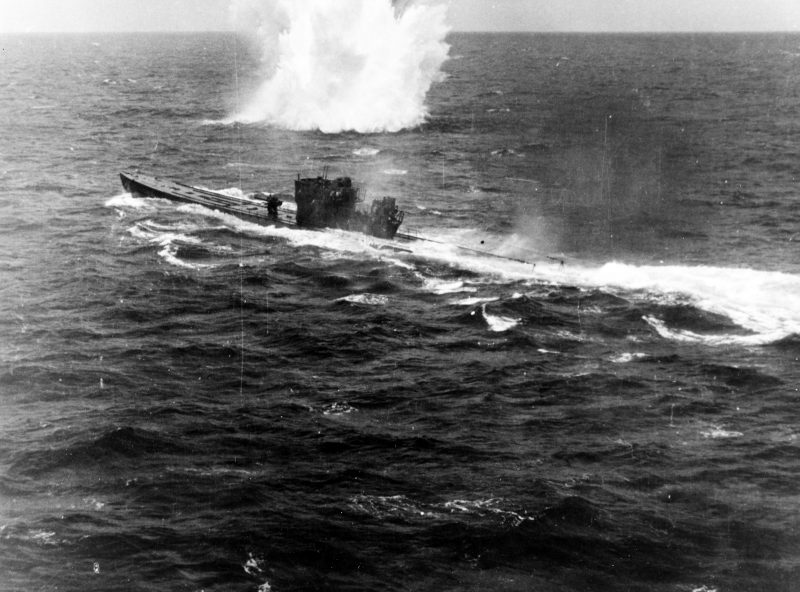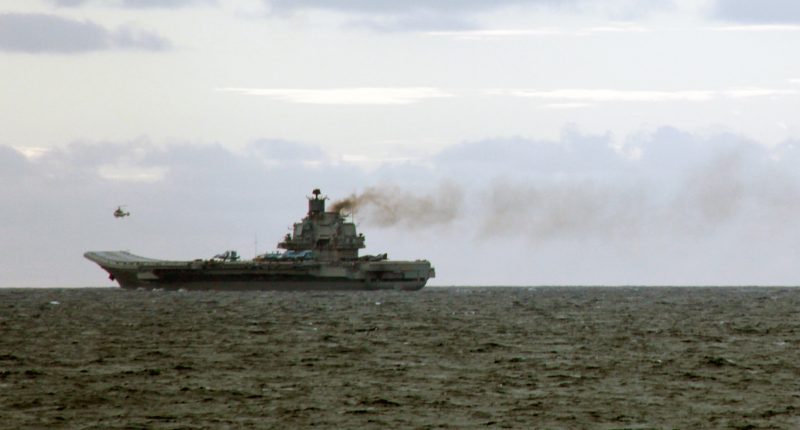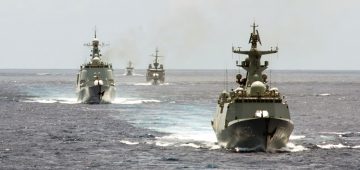A top US Navy admiral has proposed that what is in essence a fourth battle of the Atlantic is currently underway. It is, according to Vice Admiral James Foggo, a contest between Russia and the West, with strong echoes of the past, but posing a clear and present danger. Iain Ballantyne agrees and here looks at how history could be repeating itself due to the neglect of vital warfare skills and decline in naval critical mass in the West (and Britain in particular).
Featured picture: A cruise missile blasts out of the silo aboard a Russian Navy corvette during a 2015 strike on targets in Syria. Photo: Russian defence ministry.
On the evening of September 17, 1939, the elderly British aircraft carrier HMS Courageous was leading a submarine-hunting group in waters to the south west of Ireland. She was following a flawed tactic of searching out U-boats, rather than avoiding the risk to such a precious fleet asset by letting the enemy’s submarines reveal themselves while making attacks on convoys of merchant ships. Escort vessels could then, hopefully, attack and destroy them. However, there were not enough escort ships or anti-submarine specialists to always provide convoy cover.
Prior to the war the British possessed fatal belief in Asdic (sonar). They thought it neutralised U-boats, by leaving them no hiding place while submerged, so it was not necessary to have so many destroyers, hence the shortfall in escort numbers.
Kapitanleutnant Otto Schuhart of U-29 was led to Courageous after sighting one of her aircraft during a periscope look. He waited until the massive ship was compelled to follow a straight course to land aircraft and torpedoed her. Ten minutes later Courageous was gone, along with 518 of her 1,260 crew.
The loss of Courageous was a body blow to Britain and plunged First Lord of the Admiralty Winston Churchill into deep gloom. He knew what happened to politicians that failed the nation via unwise naval ventures in which big ships were lost. He had been forced to resign from the same job in WW1 due to the ill-fated Dardanelles campaign.
What made Churchill even more depressed was a visit to the main Home Fleet base at Scapa Flow in the Orkneys. He discovered to his horror that it was almost naked of anti-submarine defences, such was the lack of investment between the wars. Setting sail in Home Fleet flagship HMS Nelson – on the same day U-29 sank Courageous – Churchill was astonished to see there were no escorting destroyers. Churchill enquired of Admiral Sir Charles Forbes: “I thought you never went to sea without at least two, even for a single battleship?”
The Home Fleet commander told him there were none available. Smaller craft were, Admiral Forbes assured the First Lord, bound to be around looking out for threats.The autumn of 1939 proved to be a very black period. On 14 October Kapitanleutnant Gunther Prien took U-47 in through a gap in Scapa’s defences and sank the old battleship Royal Oak at her moorings. This time 786 men died and in subsequent months it appeared that U-boats ruled the waves, with several convoys suffering terrible losses.
In pursuing victory in the Battle of the Atlantic between 1939 and 1941, the Allies were initially hampered by ignorance of the vital need to create a cadre of highly trained, experienced submarine hunters, pursued alongside development of proper tactics and effective use of new technology (radar especially). Above all they needed to make a vast effort involving thousands of ships, aircraft and hundreds of thousands of people, including scientists and code-breakers.
That was how the British, Canadians, Americans and supporting forces won the Battle of the Atlantic for the second time. The lessons that brought victory in the first such contest in WW1 – convoying plus physical and technological dominance – had actually been learned all over again.

Just as in the 1920s and 1930s the means to master the foe were forgotten, so once again over the past 27 years since the fall of the Berlin Wall a similar amnesia has afflicted the West.
During the Cold War (1948-1991) there was a third Battle of the Atlantic. The West (through NATO) triumphed over the Russians (and Warsaw Pact) via the superiority of its technology and the excellent quality of its naval personnel and enough submarines, ships and aircraft in the right critical mass. It also operated as far forward as possible – to ensure the Russians could not rule off any ocean as their own lake.
With the end of the Cold War in 1991, the Russian submarine threat – indeed almost the whole of Russia’s massive navy – disappeared from the chart, and for two decades did not trouble the West much. NATO nations, with possible exception of the USA, dropped their guard. Investment in Anti-Submarine Warfare (ASW) forces withered. Nowhere was the decline more severe than in the Royal Navy, previously second only to the USN in terms of size and capability among NATO’s navies. It was a global leader in the field of ASW.
Today, in the face of a resurgent Russian threat – with Moscow determined to own the Arctic and zones of the North Atlantic and Mediterranean – NATO is increasing its ASW training. There have been exercises in the North Atlantic and in the Mediterranean to tighten up its talents.
There is, however, a major problem in lack of coverage related to critical mass. The UK, which at one time had a world-beating sub-hunting aircraft in the Nimrod, got rid of that asset, scrapping its entire Maritime Patrol Aircraft capability along with the ships that spearheaded ASW task groups. The UK has cut its frigates and submarines (the best anti-submarine weapons) back savagely. They are now too few and over-stretched at exactly the moment they are needed most. The rest of Europe’s navies really only have a nominal ASW capability.

There have been plenty of warnings in recent months about the growing Russian threat in the North Atlantic. In his article, published by the US Naval Institute’s esteemed Proceedings magazine this summer Vice Admiral James Foggo warned: ‘Once again, an effective, skilled, and technologically advanced Russian submarine force is challenging us. Russian submarines are prowling the Atlantic, testing our defenses, confronting our command of the seas, and preparing the complex underwater battlespace to give them an edge in any future conflict.’
He added: ‘Some analysts believe that even our underwater infrastructure – such as oil rigs and telecommunications cables – may be under threat by these new and advanced forces.’
Furthermore, he warned, the submarines of the Russian Federation are ‘one of the most difficult threats the United States has faced’ and that it is ‘only growing in complexity and capacity.’ Earlier this year the boss of NATO maritime forces, Vice Admiral Clive Johnstone, of the Royal Navy, revealed that there is “more activity from Russian submarines than since the days of the Cold War.”
There has been no commensurate reaction in political circles, no move to radically boost ASW or any other naval forces – nor bold forward deployment into the international waters of the Greenland Sea or Barents. Ship procurement programmes in Europe proceed sluggishly, while there are no RN vessels in reserve to bring forward and fit out for the job. They have been sent to scrap or sold off. The British are turning out new Offshore Patrol Vessels (OPVs) with alacrity, which are just glorified fishery protection ships and deter nobody.
The UK is so short of frigates and destroyers it even sent a fishery protection vessel to the Black Sea as its representative in a NATO exercise aimed at deterring Russian aggression. It was not much of a counter to the new cruise missile-armed corvettes and diesel-electric submarines (SSKs) Russia is introducing into service to dominate that region. In the North Atlantic, as Vice Admiral Foggo suggests, the scale of threat is much greater, not only SSKs but also new nuclear-powered attack, guided-missile and ballistic missile submarines.
So-called Cold War era Akula II and Sierra II submarines have staged provocative intrusions, deep into waters that the West – and the British in particular – used to consider their own backyard. It is an extraordinary state of affairs, especially when NATO Secretary General Jens Stoltenberg recently pointed out that ASW is “more and more relevant for the Alliance”. He feels that strong defence is not incompatible with dialogue and actually enhances it. “NATO does not seek conflict,” said the Secretary General. “Actually, we continue to strive for cooperation, for a more constructive relationship with Russia.”
Failure to maintain effective anti-submarine forces by Britain in the peace between the first two battles of the Atlantic, arguably encouraged Germany to repeat the same strategy of trying to dominate the ocean as a means to victory. It only ended in failure each time because Britain made the same huge effort.

Today Russia will only gain hegemony over the oceans if the politicians of the West do not wake up and provide the leadership and investment needed on an equally ambitious scale to create the ASW solution.
In the Russian mind, we are not engaged in a second Cold War, or even a fourth Battle of the Atlantic, for they did not lose the third one. They only withdrew for two decades to gird up their loins and push on for a victory temporarily denied them by NATO between 1948 and 1991. The so-called new Cold War is actually just a continuation of the old one.
The deployment of a Russian Navy carrier battle group, with attendant nuclear-powered and diesel-electric submarines riding shotgun, this autumn has been the latest development in the new contest for dominance of not only the North Atlantic but also the Mediterranean.
The aircraft carrier Kuznetsov has been the most visible element of Kremlin power projection, along with the nuclear battle-cruiser Peter the Great. In reality the most lethal units – with a proven ability to fire cruise missiles into Syria – are the Improved Kilo Class submarines and Buyan Class corvettes that have attracted the least attention.
Iain Ballantyne is the Editor of WARSHIPS IFR and the author of ‘Hunter Killers’ (Orion Books), which tells the story of the Royal Navy’s submarine force during the Cold War. His forthcoming book ‘The Deadly Trade’ is a history of submarine warfare, including the battles for the Atlantic. It will be published by Orion in 2017.







Comments
Sorry, comments are closed for this item